Buying a home is one of the biggest financial moves most people make. But it’s even bigger if you’re looking to buy your first home. After all, it’s a completely new experience.
If that describes you, don’t panic! Knowing how to buy your first home is just a matter of understanding all the steps and completing them one at a time.
Table of Contents
How to Prepare to Buy Your First Home
Even if you’re not quite ready to buy your first home right now, you can begin preparing. Since buying your first home is a multistep process that can take several months or even years, you can begin planning for the event right now.
And when the day comes that you’re ready, you’ll be able to move quickly.
Below are the basic steps to take to prepare to buy your first home:
1. Start Scanning the Market for Homes and Neighborhoods
This part of the process is an adventure, and it should be fun! You’re not looking for anything specific here, but mainly to get a general idea of what’s out there and what you might like.
You can use sites like Zillow and Realtor.com to begin searching for properties and neighborhoods you may be interested in.
Though this is mainly a fishing expedition, it will also help you to get a general idea of the price range you’ll be looking in. That will help you to begin getting your finances in order for the eventual purchase.
2. Get Prequalified by a Mortgage Lender
Once you have a rough idea of the price range you’ll be looking in, it’ll be time to do a preliminary evaluation of your ability to afford homes in that range. The best way to do that is to work with a mortgage lender to get prequalified.
Prequalification isn’t like a preapproval. At this point, all you’re looking to do is establish the mortgage amount you’re likely to qualify for. You don’t typically need to supply documentation, but it does help to have a credit report run.
In addition to giving you a rough idea of how much financing you can qualify for, prequalification will also provide you with an opportunity to work to improve your credit score and to begin saving for your down payment. You’ll now have specific targets to work toward.
For example, if you’re finding homes in the $300,000 price range, and the down payment is likely to be 5%, you’ll know that your down payment savings target will be $15,000.
Similarly, you’ll have an opportunity to increase your credit score. Just increasing the score by 50 points will not only get you a lower rate on your loan, but it may also qualify you for a larger mortgage. Once you’ve been prequalified, you’ll have time to improve your score.
How to Buy Your First Home With Low Income
If your income is insufficient for you to qualify for a large enough loan to purchase the house you want, you may still qualify for the loan if you add a co-borrower to the loan.
The co-borrower will need to have good or excellent credit and a stable income sufficient to help you qualify for the loan.
A co-borrower won’t enable you to qualify for an unlimited loan amount, but it will give you expanded flexibility for a larger loan, at least on the income side.
3. Choose the Right Mortgage Loan Program
Still, another advantage of going through the mortgage prequalification process is that you’ll have a chance to evaluate different mortgage programs.
There are four primary mortgage types available:
Conventional
The name refers to the fact that these loans are not sponsored by government agencies like FHA or VA. The loans are provided by banks, credit unions, and mortgage companies.
They will require private mortgage insurance (PMI) if you make a down payment of less than 20%. If so, that coverage will be provided by commercial insurance carriers.
You’ll generally need a minimum credit score of 620 to qualify for conventional financing. The minimum down payment requirement on most loans offered is 5%, but there are first-time homebuyer programs that allow down payments as low as 3%.
The maximum loan amount for single-family properties is $766,550 for 2025, but higher loan amounts are permitted on multifamily properties and homes located in areas designated as high-cost.
FHA
These are loans insured by the Federal Housing Administration, which also provides mortgage insurance for the loans. The loan limits are the same as they are for conventional, and the typical down payment is 3.5%.
That said, FHA loans are often used in conjunction with down payment assistance programs that can result in a zero down payment requirement.
One of the big advantages of FHA loans is that they have relaxed credit guidelines (compared with conventional loans). They typically accept credit scores as low as 580 but will go lower, with a down payment of at least 10%.
FHA loans may be the answer to the question: How to buy your first home with bad credit? You may be able to make a 10% down payment by getting a gift from a family member. If you can, your bad credit will be less of an issue.
VA Loans
These are loans insured by the Veterans Administration, which also establishes the loan guidelines. As the name implies, they’re available only to current eligible members of the US military, eligible veterans, and their families.
The big advantage of a VA loan is that it provides 100% financing. That eliminates the need for the borrower to come up with a down payment, which is perfect for first-time homebuyers.
Available loan amounts are similar to those for conventional and FHA loans, but you can exceed those limits. In what is known as a VA Jumbo loan, you’ll be required to make a down payment equal to 25% of the loan amount that exceeds the maximum loan amount for conventional loans.
VA loans are an obvious choice for how to buy your first home with no money down. However, they’re available only for eligible current and former members of the US military.
If you aren’t eligible for VA loans, you can consider getting either an FHA loan or a conventional loan using down payment assistance. Both offer low down payment loans, with the potential for down payment assistance programs to cover the down payment requirement.
Jumbo Loans
These are larger loan amounts – larger than those available for conventional and FHA loans – that are provided by banks and other lenders. Though the loan amounts are higher and can accommodate higher-priced properties, borrower requirements are also greater.
For example, you’ll typically be required to make a down payment of 20% or more of the purchase price. You’ll also be required to have good or excellent credit, with a credit score minimum of 680 or higher.
And because the loans are larger, you can expect slightly higher interest rates as well.
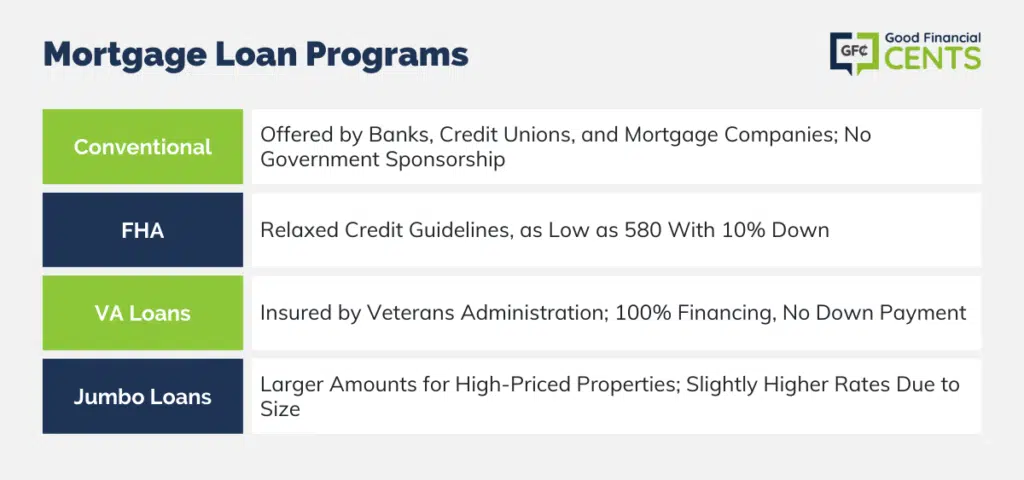
4. Get Preapproved for Your Mortgage
The main purpose of being prequalified for a mortgage is to give you an opportunity to make any improvements in your income, credit score, and savings for your down payment.
But if you’ve already completed those steps, the next will be to get formally preapproved for the financing.
Where prequalification is an indication of how much financing you’re likely to qualify for, a preapproval is a formal application with full approval of your loan.
The lender will run a formal credit report and also request documentation verifying your employment, income, and savings. With all that information in hand, they’ll be able to issue a pre-approval letter indicating that you are approved for the financing you’ve applied for.
This is an important step that should be completed just before you begin your search for a home. Both real estate agents and property sellers will want to know you’ve been preapproved for your financing before accepting any offers.
In a perfect world, your pre-approval letter will have no major conditions and require only the selection of property and customary closing procedures.
5. Start Your Home Search
Once you’ve been pre-approved for financing, it’ll be time to start the actual home search.
For many first-time homebuyers, this process will begin by choosing a good real estate agent. Make sure it’s someone who knows the local market well and has experience working with first-time homebuyers.
Provide your agent with specific details of the home you’re looking to purchase and even samples from your research on Realtor.com and Zillow.
The more information you can supply to the real estate agent, the better he or she will be able to locate the right home for you.
There are a couple of general rules to be aware of when shopping for a home:
- The Neighborhood Is More Important Than the Home. That’s because a home can be modified, but the neighborhood location can’t. For example, proximity to employment, shopping, and schools won’t change once you move into the neighborhood.
- Never Buy More House Than You Can Reasonably Afford. Be sure that the monthly payment fits neatly into your budget. An uncomfortably high house payment can easily put the rest of your budget into a tight squeeze.
- Be Sure to Get a Home Inspection. Any problems with the property identified by the home inspector can be repaired by the home seller. But if you forgo an inspection, any repairs will be paid by you. A home inspection can cost between $200 and $500, but it will be money well spent.
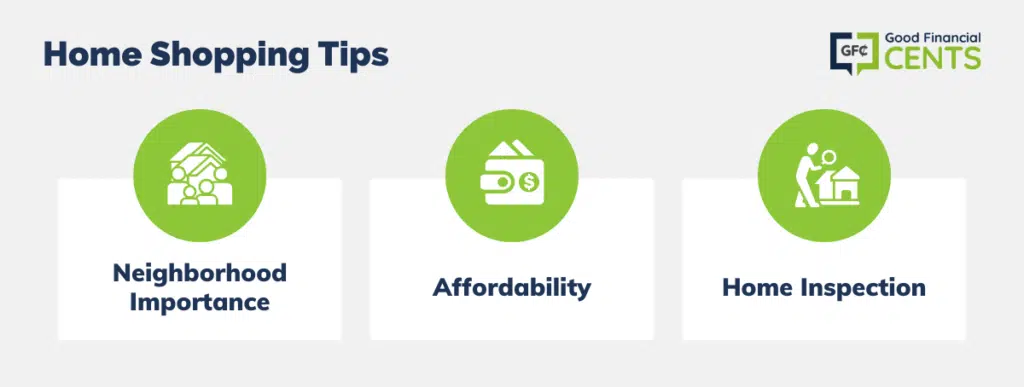
6. Be Prepared to Negotiate
When you make an offer on a home, it’s just an initial tender. The specific details will change between your initial offer and final acceptance.
There can be changes to the sale price, closing costs paid by the seller, move-in date, required repairs, and any amenities that will be included with the property.
That’s why it’s important to include a contingency within your offer for a home inspection. That contingency should require that the seller will pay for any required repairs.
The negotiation process can take several days and require revision of various details. While it’s important to be flexible, you don’t want to give up too much, either.
For example, if the seller counters with a request for a higher sale price – one that could push the monthly payment beyond your comfort level – you’ll need to counter until a mutually agreeable price is reached. But if the seller is not flexible, you may need to withdraw your offer.
Whatever you do, don’t allow yourself to be overcome with emotion during the negotiating process. It’s important to remember buying your first home is as much a financial transaction as it is anything else. If the terms become unfavorable, be ready to move on to another property.
7. Get Ready for Your Move
If you select the home and your offer has been accepted, it’ll be time to get ready for your move. This can be a stressful time because it involves a lot of details.
Here’s a checklist to help you to be ready:
- Decide if you’ll be doing a self-move or you’ll be hiring the job out to a professional mover.
- If it’s a self-move, you’ll need to reserve a moving truck and buy packing supplies. You’ll probably also need to line up as much help as you can get from family and friends.
- If you’ll be using a professional mover, get quotes from three or four providers before making your choice.
- Have a budget for whatever the cost will be, and be sure you have the funds available to cover it.
- If you’re doing a self-move, begin packing immediately. Even if you’re hiring professionals, you may want to do your own packing. Professional movers increase the fees substantially when packing is added to the move.
- Change your address with the post office, as well as the Department of Motor Vehicles, banks and other financial institutions, creditors, and family and friends.
- You’ll need to change your utilities before you move. That will mean terminating utilities at your current address and establishing them in the new home.
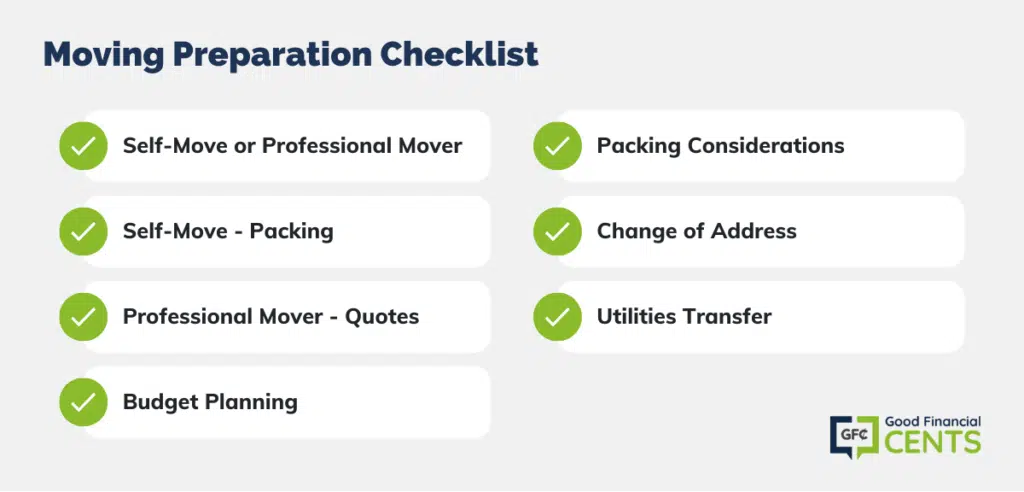
The better prepared you are for moving day, the less stressful the homebuying process will be. This will be especially important since the move generally comes immediately after the closing of the new home, and that can be a major source of stress all by itself.
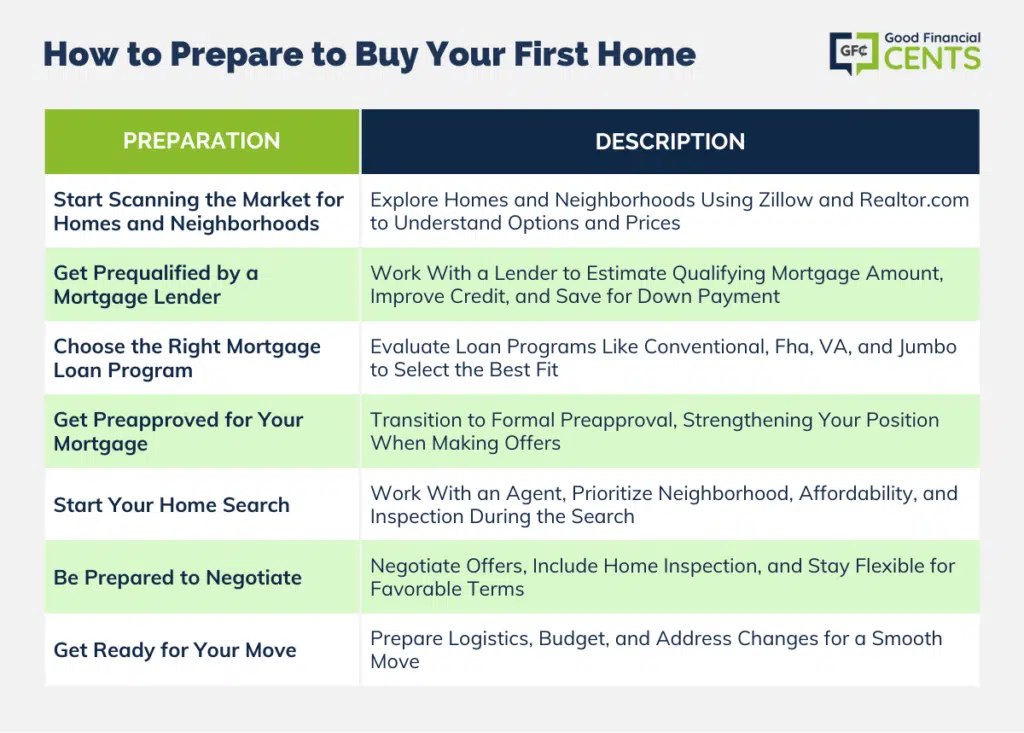
Where to Get Financing to Buy Your First Home
There are many hundreds of institutions offering mortgage financing, including local banks and credit unions. However, few of those specialize in mortgage financing, and they don’t always offer the best rates.
Start your search by working with large, national lenders. Not only do they operate across the country, but mortgage lending is primarily what they do, and they also offer highly competitive rates.
One of the best examples is Rocket Mortgage. It’s the online face of Quicken Loans, the largest retail mortgage lender in the country. Not only do they provide all types of mortgage loans, but they operate entirely online, streamlining and speeding the application process.
loanDepot is another online, nationwide mortgage lender. They offer conventional, Jumbo, FHA and VA loans. You’ll complete the loan application online and upload any documentation directly onto the website.
That will give you the flexibility to make applications from the comfort of your home or even your workplace.
If you’re looking for a VA loan, look no further than Veterans United. Not only do they specialize in VA mortgages, but they’re the largest VA mortgage lender in the country.
The company consults with former senior enlisted members of each branch of the US military to make the lending process as user-friendly as possible for veterans and active-duty members of the military.
If you prefer to shop between lenders, consider Credible. It’s an online loan marketplace offering loan quotes from multiple lenders.
You’ll complete a brief online application and receive quotes from those that offer programs that will interest you. It’s an excellent choice if you’re looking to locate the lender with the best rate and terms for your loan.
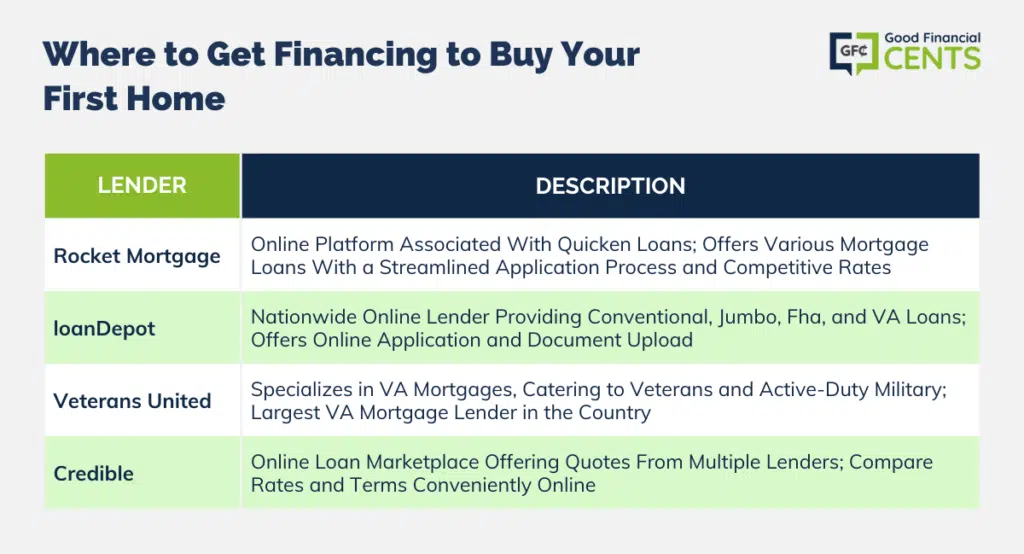
Final Thoughts – How to Buy Your First Home
Buying your first home might seem like a daunting task, but with careful preparation and a step-by-step approach, it can become a manageable and exciting journey.
Begin by familiarizing yourself with the market and neighborhoods, followed by getting prequalified by a mortgage lender to understand your financial capacity.
Choose the right mortgage program that suits your needs, and then move on to getting preapproved for your loan, which strengthens your negotiating position.
The home search process should prioritize neighborhood and affordability, while negotiations should be approached pragmatically. Finally, prepare for the move with careful planning and attention to detail.







